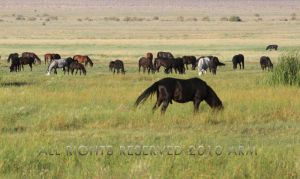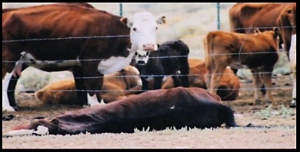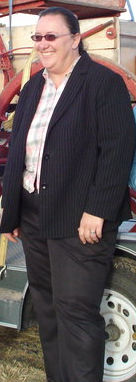From the highway it is a beautiful sight. A giant blue lake, with greenery all around and the desert mountains behind it in the stark blue summer sky. Its hard to take your eyes off of the scenery, so be careful driving. Far off in the distance you can barely make out some moving dots next to the lake. They are easily mistaken for a large herd of cows, many blacks and some whites and greys. But they are definitely not cows, they are a most magnificent herd of wild and free roaming horses living in a most spectacular peace of nature, still untouched by man.
Kudo, (founder of Animal Recovery Mission in Miami, working to close the horrendous illegal slaughter farms there) and myself, (founder of Respect4horses in Arizona), have decided to temporarily veer off of our main courses a bit to join forces and go document the wild horse roundups in Twin Peaks, CA. As we are driving on the road towards Fallon, where we want to visit the broken arrow holding facility, we noticed the lake and the dots along side of it and we decide to turn around, just to check in case they might be horses. I am so glad that we did.
As we descend down the hill and approach them carefully in a zigzagging manner, we are starting to see more and more horses. First we estimate about fifty, then another twenty, then another thirty behind the reeds. We are in awe of the size of the herd, as they are all together, not separated and not hostile towards each other. It is very interesting, as herd dynamics usually don’t allow for this large of a grouping together without altercations between small bands. The sounds of their soft whinnying, the sight of the bachelors playing together, and the feel of the harmony of all of them grazing as one large family; these are by far the most peaceful and happy animals I have ever had the privilege to come across in my life.
All of a sudden a gorgeous black stallion with a white blaze and a pink nose looks up, turns towards us and blows his nostrils furiously. The entire herd looks up from their dinner. Looking at us and trying to estimate the amount of danger we might present, he looks back and communicates with the herd. It seems that they don’t see people often, they are untouched, and no brands. Still they maintain undisturbed and are patiently waiting for his judgment call, it is clear that they rely on him completely. He must be quite a horse having gained the trust of so many.
All the horses have beautiful confirmation; they are quite fat and very shiny. We counted approximately ten babies of varying ages and two mares still very heavily pregnant. I noticed the adorable mare and baby pair closest to the stallion because the baby is a remarkable black and white paint with funny marking and a white face. There are also some beautiful greys and two pure whites, but the bulk of the herd is black and dark bay, many with very similar markings on their faces, just like the brave stallion.
He starts to paw the ground, makes himself large and starts to prance from left to right and back and forth. We back up a little to make him more comfortable. This gives him courage and he trots around so magnificently, with his posture and extension and reach, that he would have won best in show at any dressage competition. He gets braver and comes closer to us, all the while still blowing his nostrils loudly.
It is such a rare glimpse into the lives of these very happy horses, and such a magical experience, that I am thinking, this might just be the perfect spot to start with ecotourism. They are very easily accessible off the main highway 95 and easy to spot because you can overlook the entire valley. There are not many areas where this would be a possibility. A viewing deck overlooking the meadows and the lake would be perfect for an audience and at the same time perfect for the horses’ safety.The stallion has decided he is not going to let us run them off, the herd goes back to their dinner as he starts to walk in a big circle around us. His attitude and his face are so beautiful, he will be engrained in my memory like that forever. We named him Walker, after the lake that he thinks is his. This is the Walker Lake Herd.
According to the BLM they come from the Pilot Mountain and Pine Nut HMA’s. We were absolutely horrified to find out that they are slated for roundup and complete removal, in November. (BLM comment period is open now, please read this article till the end to find out how you can help)
For the ones who know better, the BLM strategies are easier to see through than our dirty truck windows, but for mainstream America whom are occupied with their own lives and worries, they are pretty clever. The overpopulation claim fabrication is a brilliant front for ridding America of the last of our remaining wild horses. Masterfully hiding true reasons and motives, the PR writers make the BLM look like honest to goodness hero’s, utilizing the concoctions of starvation, dehydration and range deterioration.
In the case of the Walker Lake Herd obviously none of these perfectly fine reasons can be applied as there is absolutely no damage to the rangelands and no one would argue the other two points. So I wondered what they could possibly come up with. But not for long, when I read it I wondered why I didn’t think of it myself …public safety hazard, of course. Plus also, according to the website, they have wandered outside their HMA’s. Really? What is the reason that the lake is not within their HMA? Obviously horses will congregate towards a lake, it is more than a little sneaky not to include it in their HMA. And, according to the local people they have always been there. It is so pointless and discouraging. If their concern for the public safety was of an honest nature, then why not put a fence by the road? That is a lot less costly than a roundup operation that is not necessary, even by any of their own standards.
What is really scary is that it is not just our horses that are at stake. It is our wildlife, our water streams, lakes and groundwater, ecosystems, nature etc. Just like the rainforests of the world are being destroyed for their resources, so is the BLM selling our public lands for its minerals, natural gas, forage and don’t forget, water. The BLM is well on their way to turning America’s beautiful pristine wildernesses into giant filthy cattle farms scattered with mining pits, water extraction and gas pipelines.
According to a little 1872 mining law, also known as the General Mining Act, which is still in effect today, (can you imagine if we still lived by all the laws from 1872?), mining companies can mine what they want without the need to pay royalties to the federal government, paying only a small annual claim fee. You can imagine that this makes America the Mecca for foreign extraction companies to make a fortune. As BLM has full deciding powers over 245 million acres of public lands, the power this gives them is limitless. It puts Ken Salazar’s bank account right up there with rainforest Gorillas, on my list of most interesting things I’d like to see in my lifetime.
No one can really say for sure, until an independent count has been conducted, but according to the BLM there are over 35,000 horses left in the wild, according to some wild horse protection organizations there are less than 20,000. I personally tend to believe the wild horse organizations, but let’s compromise and take the average of those numbers and say it is approximately 27,500 that are still roaming wild, not costing anyone a dime while they live their lives in peace and harmony.
We have over 654 million acres of federal land in America of which 245 million acres are (mis-) managed by the BLM and 190 million by the Forest Service (who are also decimating wild horses). Of those 245 million acres the BLM has designated 134 million acres for cattle grazing solely. Meaning, no wild horses or predators are allowed and very few wildlife.
If a horse dares to wonder onto those acres, he is removed immediately, and predators like wolves, coyotes, foxes, mountain lions and bobcats, are allowed to be trapped and exterminated, or even worse, used for sick (yet perfectly legal) canned hunting games and coyote and fox penning, where dogs gang up on the scared and injured animals and tear them to pieces being cheered on by an audience. (Yes, here in America)
Of that 245 million acres, they have ever so graciously left approximately 26 million acres where horses are allowed to exist. It used to be 19 million acres more and 330 HMA’s instead of 180, but they have taken those 19 million acres away from the horses for all kinds of mysterious and inexplicable reasons. These are some of the explanations on the BLM’s own website for the missing acres: -Urban expansion. -Land was unsuitable for wild horses and burros. (really? If they lived there, apparently it was suitable) -Habitat fragmentation. -Land withdrawals. -Serious conflict of resources. (Serious, ok) -Exchanges transferring land from BLM ownership to other parties. Oh, you mean you sold the land that you were supposed to protect horses on??
Of those 26 million acres left for the horses, you might think the horses could live in peace, but no, they have to compete with the cattle and the ranchers for water and forage. Only 4 out of 180 Herd Management Areas’ have no cattle on them and are managed principally for the horses, the rest are principally managed for the cattle. The cattle (even in AUM’s) outnumber the horses in all those herd management area’s, sometimes by as much as 50 to 1! In the case of Twin Peaks, the horses have been allocated 18% of the resources and this is actually more than some HMA’s.
Our public lands are public and so one would assume that everything on it is public, but the opposite is the case. The most crucial and valuable necessity for all life: WATER, and the rights to it, is privately owned and controlled by the ranchers. Yes, they privately own most of the wells, springs, creeks, aquifers and ponds, on our public lands, pretty much every green place where horses and wildlife like to hang out. So the horses depend on the kindness and goodness of the ranchers who are in control. Many are not so inclined to share fairly and fence the horses off from their water sources.
Now if the BLM used half way humane methods of rounding up horses, perhaps we all wouldn’t have sat up and noticed and gotten this outraged. Using a contractor that has been convicted of killing wild horses? Using Walmart bag whip sticks instead of natural horsemanship? Stuffing scared wild horses in trucks and driving them for hours right after they ran for miles and miles? Rounding them up in the middle of foaling season, in the middle of extreme temperatures? Dusty, filthy holding facilities that provide no shade or cover whatsoever? Only one veterinarian for every 3000 horses? Shooting them from the air and calling it euthanasia? Shouldn’t our government be the poster child for normal modern standards of basic animal welfare, in order to rule by example?
If they would insist, and we had to compromise, we can offer far better ways to rounding up horses than chasing them with low flying helicopters. As a horse trainer and behavioral expert, I positively think that better ways would be fairly easy and as a boon, a lot less costly to apply. We would lure them into one giant 5 acre large meadow with some food, over a little bit of time so they could get used to the meadow, and then close the entrance. It could be done with accredited natural horsemanship techniques, instead of by cow herders with walmart bag whip sticks. It could be done with zero mental trauma to the horses, and zero physical trauma to their ligaments, bones and hooves. It could be done with 0% fatality rate as apposed to 6% fatality rate. This is the year 2010, we have better ways. An independent agency should look into this method and I’d be more than happy to explain it to them and conduct a study on it.
27,500 horses on 26 million acres is a ridiculously low number, if you understand how vast 26 million acres of land truly is, it’s larger than some European countries. In the case of Twin Peaks, 450 horses are allowed back in an HMA which spans close to 800,000 acres. This comes down to 1 horse per 1770 acres! In all reality one horse could roam on 100 acres and never be able to eat all the forage on it before it grew back.
So good luck finding a horse if you would like to go see one in the wild. Ecotourism is really not an option if it is more difficult to find a wild horse in America than it is to find an elephant in Africa.
These 26 million acres constitute only 4% of all federal lands in America. (not counting private lands of course) Meaning, 96% has not one wild horse on it. What we want is for the horses to be allocated at least 50% of the resources on their own HMA’s where they are supposed to be managed principally, but not exclusively. I don’t know which dictionary they have on their bookshelf, but according to any that I have ever read, principally means, given most priority, the bulk, mainly, most importantly, most of it.
We basically want, what they already have a lawful right to, and what is already clearly stated in the law, and it is pretty outrageous that we have to ask for it. We also want the horses where possible to be separated from the cattle, so no one has to compete for water, no one will be fenced off from water and no one has to argue who is deteriorating what. We want 50% of the 26 million acres only, because we wouldn’t want to be unreasonable towards the ranchers, now would we.
So in all seriousness, we are asking for a mere 2% of federal lands in America. 2 percent for them to be left alone and live in peace, and we would save ourselves a whole lot of money and effort at the same time.
In regards to the Walker Lake herd, they are a perfect example of how ludicrous the BLM policies and excuses are. They are a herd that needs to be studied and documented, a herd that the public should be able to observe, a herd that should be allowed to be un-traumatized and untouched. We need untouched and untraumatized herds, if for nothing else, for the research value of their behaviors. None of the BLM excuses apply here, none of them.
So please submit your comments now. Write your letter specifically for this herd. We will ask them nicely to solve the public safety hazard risk by placing a fence by the road. We will ask them nicely to place a viewing deck for the public and we will ask them nicely to leave them the heck alone. I hope you will all join me in sending many letters, but please make sure that you copy them to Respect4horses (simone@respect4horses.com) to Salazar, and to the president and to your own Congressman and Senators, because otherwise, they say they never got them. (I have a PR person on film saying that they didn’t get any comments) I will meet with a high ranking BLM figure in regards to this herd, but I need lots of letters (please send to my email above) Contact info for submitting your comments to the BLM are below this article.
For their overall management strategy, lets make the message clear and simple. 2% for the last remaining 27,500 truly wild horses. Is it really too much to ask? Do we not owe them one grain of gratitude for carrying us into this day and age? They are an unbelievably beautiful sight to see, they have miraculously survived on their own for hundreds of years and have evolved into an amazingly tough and beautiful species. The untouched herds have wonderful family structures and amazing herd dynamics, they need to be studied and documented and appreciated. It is truly a sight that future generations will want to see.
2% of America,.. for the ones on whose back we settled it in the first place.
“At which point do we start prioritizing our compassion and humanity over power and greed? For it is precisely at this point at which the world starts to become a better place.” - Simone Netherlands.
****Written comments for the Clan Alpine/Pilot Mountain/Pine Nut Gather Plan and EA will be accepted through September 23, 2010, should be directed to: ccwhbEA_2010@blm.gov (note there is an underscore in between EA_2010) or mail to Stillwater Field Office Manager Teresa Knutson and Sierra Front Field Manager Linda Kelly, 5665 Morgan Mill Rd., Carson City, NV 89701. Direct phone inquiries to Steve Kramer, Planning & Environmental Coordinator, 775-885-6005. Only email comments received through the identified e-mail addresses will be considered. Written comments for either EA can also be sent via FAX to 775-885-6147.
Link to BLM site: http://www.blm.gov/nv/st/en/fo/carson_city_field/blm_programs/wild_horse_and_burro/pine_nut_mountains0.html
Simone Netherlands, Respect4horses Organization http://www.respect4horses.com













